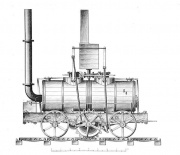Fenton, Murray and Wood: Salamanca
The Salamanca' was the first commercially successful steam locomotive - it was designed by Matthew Murray in 1812 and built by Fenton, Murray and Wood for the Middleton Colliery Railway in Leeds.
The Salamanca was a rack and pinion locomotive using the design of John Blenkinsop for rack propulsion. A single rack ran outside the narrow gauge tracks and was engaged by a cog wheel on the left side of the locomotive. The cog wheel was driven by two cylinders embedded into the top of the center-flue boiler.
Four such locomotives were built for the railway, and they worked until the early 1830s.
The class was described as having two 8" x 20" cylinders, driving the wheels through cranks. The piston crossheads worked in guides, rather than being controlled by parallel motion like the majority of early locomotives. The engines saw up to twenty years of service.
Four such locomotives were built for the railway. Salamanca was destroyed six years later, when its boiler exploded. According to George Stephenson, giving evidence to a committee of Parliament, the driver had tampered with the boiler safety valve
See Also
- [1] Wikipedia



